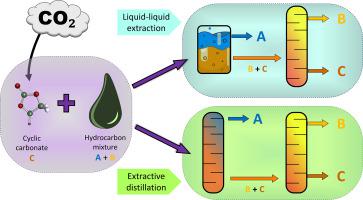当前位置:
X-MOL 学术
›
Fuel Process. Technol.
›
论文详情
Our official English website, www.x-mol.net, welcomes your
feedback! (Note: you will need to create a separate account there.)
Multiscale evaluation of CO2-derived cyclic carbonates to separate hydrocarbons: Drafting new competitive processes
Fuel Processing Technology ( IF 7.2 ) Pub Date : 2021-02-01 , DOI: 10.1016/j.fuproc.2020.106639 Elisa Hernández , Rubén Santiago , Cristian Moya , Pablo Navarro , José Palomar
Fuel Processing Technology ( IF 7.2 ) Pub Date : 2021-02-01 , DOI: 10.1016/j.fuproc.2020.106639 Elisa Hernández , Rubén Santiago , Cristian Moya , Pablo Navarro , José Palomar

|
Abstract Current chemical technologies present a negative impact on society and environment since they are based on processes that demand large energy and the use organic solvents, entailing relevant carbon footprint. Emerging solvents impose additional criteria in the design of new separation technologies. Aiming at addressing favorable solvent properties but also reducing emissions of carbon dioxide, cyclic carbonates are CO2-based synthesizable designer solvents unexplored in the literature. Cyclic carbonates are a new class of tunable compounds with ability to enhance current standards and improve the sustainability of processes. Here a comprehensive and systematic study, covering fundamental and process scale insights, is developed on the use of cyclic carbonates in the most relevant hydrocarbon separations in the literature, namely {n-heptane + toluene}, {cyclohexane + benzene} and {cyclohexane + cyclohexene} by liquid-liquid extraction and extractive distillation. A priori COSMO-RS method described the driving interactions between cyclic carbonates and hydrocarbons, whereas COSMO-based/Aspen was used to further inspect phase equilibria and design liquid-liquid extraction and extractive distillation separation processes, using benchmark industrial solvents (sulfolane and N-formylmorpholine). The favorable process performance starts a new research line to fine-tune cyclic carbonates' structure, but currently drafting feasible approaches, competitive or even better when compared with conventional solvents.
中文翻译:

二氧化碳衍生环状碳酸酯分离碳氢化合物的多尺度评估:起草新的竞争过程
摘要 当前的化学技术对社会和环境产生了负面影响,因为它们基于需要大量能源和使用有机溶剂的过程,从而产生相关的碳足迹。新兴溶剂对新分离技术的设计提出了额外的标准。为了解决有利的溶剂特性,同时减少二氧化碳的排放,环状碳酸酯是文献中未探索的基于 CO2 的可合成设计溶剂。环状碳酸酯是一类新的可调化合物,能够提高当前的标准并提高工艺的可持续性。这里对环状碳酸酯在文献中最相关的碳氢化合物分离中的使用进行了全面系统的研究,涵盖了基本和工艺规模的见解,即{正庚烷+甲苯}、{环己烷+苯}和{环己烷+环己烯}通过液液萃取和萃取精馏。先验 COSMO-RS 方法描述了环状碳酸酯和碳氢化合物之间的驱动相互作用,而基于 COSMO/Aspen 的方法则用于使用基准工业溶剂(环丁砜和 N-甲酰吗啉)。良好的工艺性能开启了微调环状碳酸酯结构的新研究路线,但目前正在起草可行的方法,与传统溶剂相比具有竞争力甚至更好。先验 COSMO-RS 方法描述了环状碳酸酯和碳氢化合物之间的驱动相互作用,而基于 COSMO/Aspen 的方法则用于使用基准工业溶剂(环丁砜和 N-甲酰吗啉)。良好的工艺性能开启了微调环状碳酸酯结构的新研究路线,但目前正在起草可行的方法,与传统溶剂相比具有竞争力甚至更好。先验 COSMO-RS 方法描述了环状碳酸酯和碳氢化合物之间的驱动相互作用,而基于 COSMO/Aspen 的方法则用于使用基准工业溶剂(环丁砜和 N-甲酰吗啉)。良好的工艺性能开启了微调环状碳酸酯结构的新研究路线,但目前正在起草可行的方法,与传统溶剂相比具有竞争力甚至更好。
更新日期:2021-02-01
中文翻译:

二氧化碳衍生环状碳酸酯分离碳氢化合物的多尺度评估:起草新的竞争过程
摘要 当前的化学技术对社会和环境产生了负面影响,因为它们基于需要大量能源和使用有机溶剂的过程,从而产生相关的碳足迹。新兴溶剂对新分离技术的设计提出了额外的标准。为了解决有利的溶剂特性,同时减少二氧化碳的排放,环状碳酸酯是文献中未探索的基于 CO2 的可合成设计溶剂。环状碳酸酯是一类新的可调化合物,能够提高当前的标准并提高工艺的可持续性。这里对环状碳酸酯在文献中最相关的碳氢化合物分离中的使用进行了全面系统的研究,涵盖了基本和工艺规模的见解,即{正庚烷+甲苯}、{环己烷+苯}和{环己烷+环己烯}通过液液萃取和萃取精馏。先验 COSMO-RS 方法描述了环状碳酸酯和碳氢化合物之间的驱动相互作用,而基于 COSMO/Aspen 的方法则用于使用基准工业溶剂(环丁砜和 N-甲酰吗啉)。良好的工艺性能开启了微调环状碳酸酯结构的新研究路线,但目前正在起草可行的方法,与传统溶剂相比具有竞争力甚至更好。先验 COSMO-RS 方法描述了环状碳酸酯和碳氢化合物之间的驱动相互作用,而基于 COSMO/Aspen 的方法则用于使用基准工业溶剂(环丁砜和 N-甲酰吗啉)。良好的工艺性能开启了微调环状碳酸酯结构的新研究路线,但目前正在起草可行的方法,与传统溶剂相比具有竞争力甚至更好。先验 COSMO-RS 方法描述了环状碳酸酯和碳氢化合物之间的驱动相互作用,而基于 COSMO/Aspen 的方法则用于使用基准工业溶剂(环丁砜和 N-甲酰吗啉)。良好的工艺性能开启了微调环状碳酸酯结构的新研究路线,但目前正在起草可行的方法,与传统溶剂相比具有竞争力甚至更好。











































 京公网安备 11010802027423号
京公网安备 11010802027423号